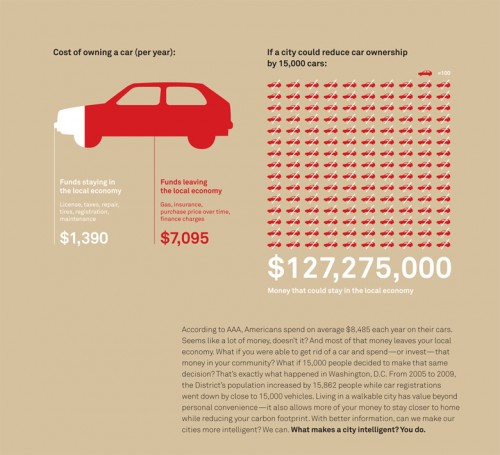
Localization of spending via bicycle
Help strengthen Denton’s economy – by riding a bike and walking. According to AAA, Americans spend an average of $9,641 on their cars per year. Now imagine that amount staying in your vicinity. Now imagine 2,000 other Dentonites doing that. That’s $19,282,000.
On the heels of Fortworthology’s article, Boost the Local Economy – Cut Car Ownership, I finally made a graphic to show the geography of where I spend my money in Denton by foot and by bike. Back when I drove everywhere, this bubble was so huge that it passed the city limits, as I might’ve driven to Costco in Lewsiville or Sprouts Market in Flower Mound. Even within Denton, I used to spend far more money at the Loop 288 stores than I do now, but that was years ago.
Now I get my groceries, coffee, laundry, hardware, and just about anything else I need by bike or on foot. As shown in the above graphic, the businesses in my bike-friendly bubble have hugely benefitted. But the benefit is two-fold. Not only is my spending localized, but having sold one car, I have far more money to spend, so the effect is amplified. The money that I would’ve spent on car payments, fuel, and insurance is now funding that fancy dessert, or that generous tip for a deserved waiter, or ice cream at Beth Maries, or a nice bottle of beer from the Midway Mart. All in all, the bubble has almost everything I need for a cozy existence.
As ridership continues to grow, I’m seeing bikes chained to handrails everywhere (in lieu of racks), and I know I’m not the only one spending within the bubble. It’s self-reinforcing. Add some bike lanes, bike-friendly signals, and racks, and we’ll bolster the local economy and jobs market even more.
As the city council election cycle ramps up toward May, you’ll hear endless candidate quotes about encouraging business growth in Denton. Most candidates will focus on business regulation and taxation, road expansion, etc. Don’t be afraid to suggest that we could retain that extra ~$20 million by getting 2,000 more people to bike or walk. We know transportation and economic development are intertwined, so let’s consider more than just car parking spots and road expansion.
This image from ctdatahaven.org shows how much money D.C. got back by reducing car ownership by 15,000, despite the same amount of population growth:











